Burn Injury in Paediatrics: A Case Study of Zaynab - HC3081 Cardiff
VerifiedAdded on 2023/06/15
|9
|3913
|168
Case Study
AI Summary
This case study focuses on the management of a five-year-old girl named Zaynab, who suffered second-degree scalding burns. It explores the perspectives of various healthcare professionals, including Operating Department Practitioners (ODPs), Surgical Theatre Practitioners (STPs), and anaesthetists, in her care. The study discusses the importance of early excision of necrotic tissue, managing fluid replacement, and addressing potential respiratory insufficiency. It also highlights the psychological interventions required for both the patient and her family to improve body image, self-esteem, and reduce anxiety, considering Zaynab's developmental stage. Furthermore, the case study delves into the legal and ethical issues surrounding consent and the rights of the child in medical practice, emphasizing the need for a multidisciplinary approach to ensure the child's mental and physical well-being before reintegration into society. The student document is available on Desklib, a website offering study tools and resources for students.
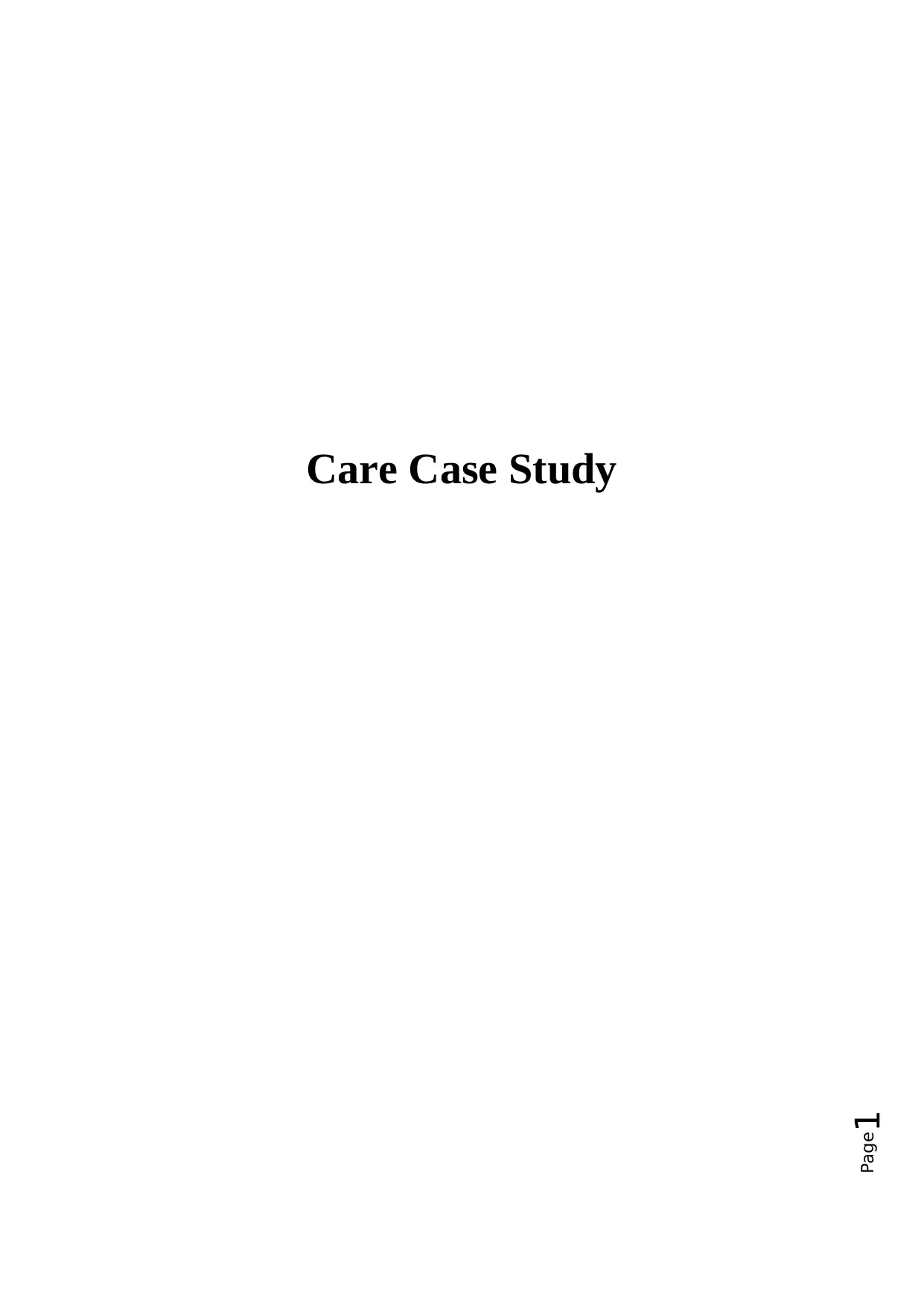
Page1
Care Case Study
Care Case Study
Paraphrase This Document
Need a fresh take? Get an instant paraphrase of this document with our AI Paraphraser
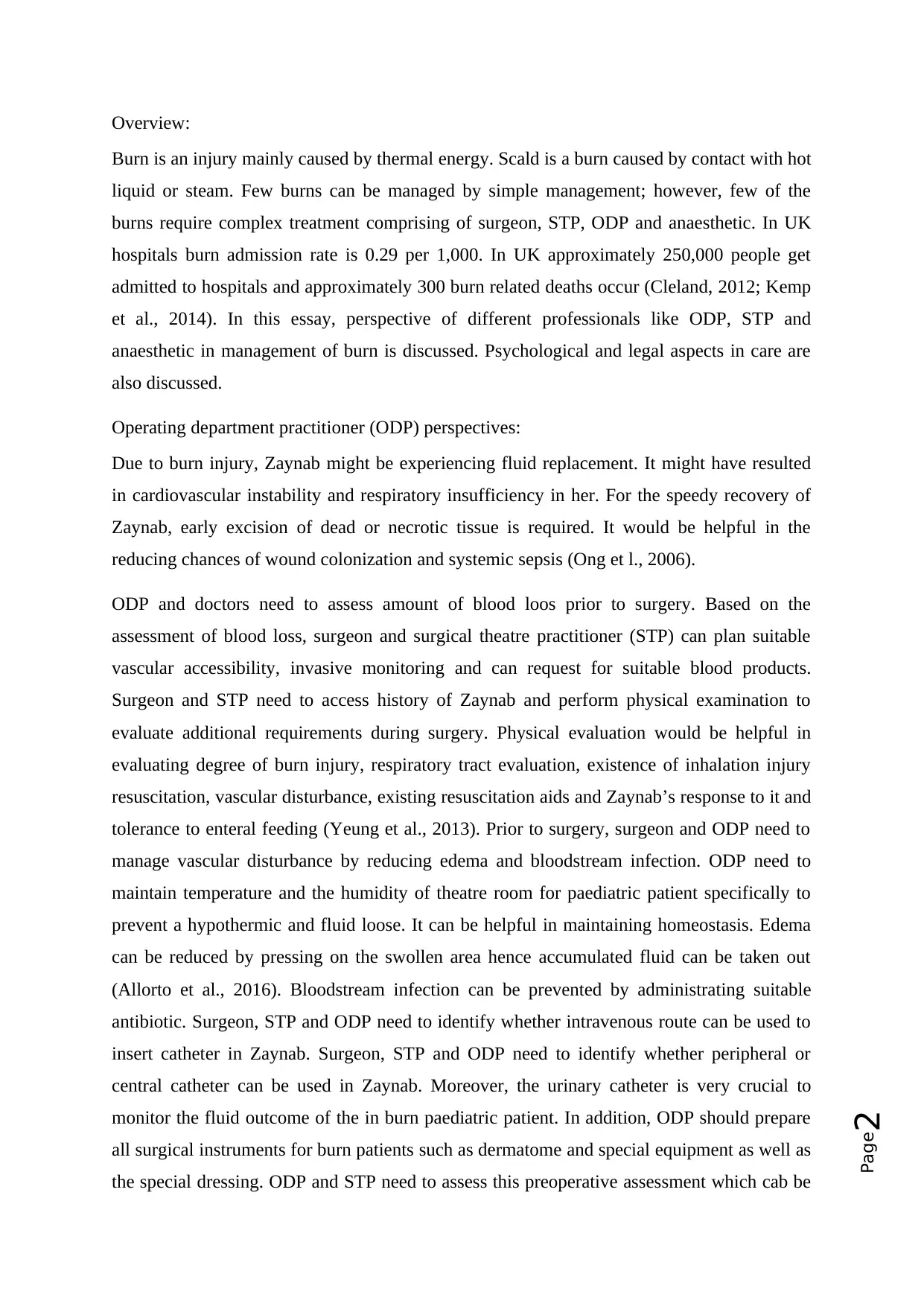
Page2
Overview:
Burn is an injury mainly caused by thermal energy. Scald is a burn caused by contact with hot
liquid or steam. Few burns can be managed by simple management; however, few of the
burns require complex treatment comprising of surgeon, STP, ODP and anaesthetic. In UK
hospitals burn admission rate is 0.29 per 1,000. In UK approximately 250,000 people get
admitted to hospitals and approximately 300 burn related deaths occur (Cleland, 2012; Kemp
et al., 2014). In this essay, perspective of different professionals like ODP, STP and
anaesthetic in management of burn is discussed. Psychological and legal aspects in care are
also discussed.
Operating department practitioner (ODP) perspectives:
Due to burn injury, Zaynab might be experiencing fluid replacement. It might have resulted
in cardiovascular instability and respiratory insufficiency in her. For the speedy recovery of
Zaynab, early excision of dead or necrotic tissue is required. It would be helpful in the
reducing chances of wound colonization and systemic sepsis (Ong et l., 2006).
ODP and doctors need to assess amount of blood loos prior to surgery. Based on the
assessment of blood loss, surgeon and surgical theatre practitioner (STP) can plan suitable
vascular accessibility, invasive monitoring and can request for suitable blood products.
Surgeon and STP need to access history of Zaynab and perform physical examination to
evaluate additional requirements during surgery. Physical evaluation would be helpful in
evaluating degree of burn injury, respiratory tract evaluation, existence of inhalation injury
resuscitation, vascular disturbance, existing resuscitation aids and Zaynab’s response to it and
tolerance to enteral feeding (Yeung et al., 2013). Prior to surgery, surgeon and ODP need to
manage vascular disturbance by reducing edema and bloodstream infection. ODP need to
maintain temperature and the humidity of theatre room for paediatric patient specifically to
prevent a hypothermic and fluid loose. It can be helpful in maintaining homeostasis. Edema
can be reduced by pressing on the swollen area hence accumulated fluid can be taken out
(Allorto et al., 2016). Bloodstream infection can be prevented by administrating suitable
antibiotic. Surgeon, STP and ODP need to identify whether intravenous route can be used to
insert catheter in Zaynab. Surgeon, STP and ODP need to identify whether peripheral or
central catheter can be used in Zaynab. Moreover, the urinary catheter is very crucial to
monitor the fluid outcome of the in burn paediatric patient. In addition, ODP should prepare
all surgical instruments for burn patients such as dermatome and special equipment as well as
the special dressing. ODP and STP need to assess this preoperative assessment which cab be
Overview:
Burn is an injury mainly caused by thermal energy. Scald is a burn caused by contact with hot
liquid or steam. Few burns can be managed by simple management; however, few of the
burns require complex treatment comprising of surgeon, STP, ODP and anaesthetic. In UK
hospitals burn admission rate is 0.29 per 1,000. In UK approximately 250,000 people get
admitted to hospitals and approximately 300 burn related deaths occur (Cleland, 2012; Kemp
et al., 2014). In this essay, perspective of different professionals like ODP, STP and
anaesthetic in management of burn is discussed. Psychological and legal aspects in care are
also discussed.
Operating department practitioner (ODP) perspectives:
Due to burn injury, Zaynab might be experiencing fluid replacement. It might have resulted
in cardiovascular instability and respiratory insufficiency in her. For the speedy recovery of
Zaynab, early excision of dead or necrotic tissue is required. It would be helpful in the
reducing chances of wound colonization and systemic sepsis (Ong et l., 2006).
ODP and doctors need to assess amount of blood loos prior to surgery. Based on the
assessment of blood loss, surgeon and surgical theatre practitioner (STP) can plan suitable
vascular accessibility, invasive monitoring and can request for suitable blood products.
Surgeon and STP need to access history of Zaynab and perform physical examination to
evaluate additional requirements during surgery. Physical evaluation would be helpful in
evaluating degree of burn injury, respiratory tract evaluation, existence of inhalation injury
resuscitation, vascular disturbance, existing resuscitation aids and Zaynab’s response to it and
tolerance to enteral feeding (Yeung et al., 2013). Prior to surgery, surgeon and ODP need to
manage vascular disturbance by reducing edema and bloodstream infection. ODP need to
maintain temperature and the humidity of theatre room for paediatric patient specifically to
prevent a hypothermic and fluid loose. It can be helpful in maintaining homeostasis. Edema
can be reduced by pressing on the swollen area hence accumulated fluid can be taken out
(Allorto et al., 2016). Bloodstream infection can be prevented by administrating suitable
antibiotic. Surgeon, STP and ODP need to identify whether intravenous route can be used to
insert catheter in Zaynab. Surgeon, STP and ODP need to identify whether peripheral or
central catheter can be used in Zaynab. Moreover, the urinary catheter is very crucial to
monitor the fluid outcome of the in burn paediatric patient. In addition, ODP should prepare
all surgical instruments for burn patients such as dermatome and special equipment as well as
the special dressing. ODP and STP need to assess this preoperative assessment which cab be
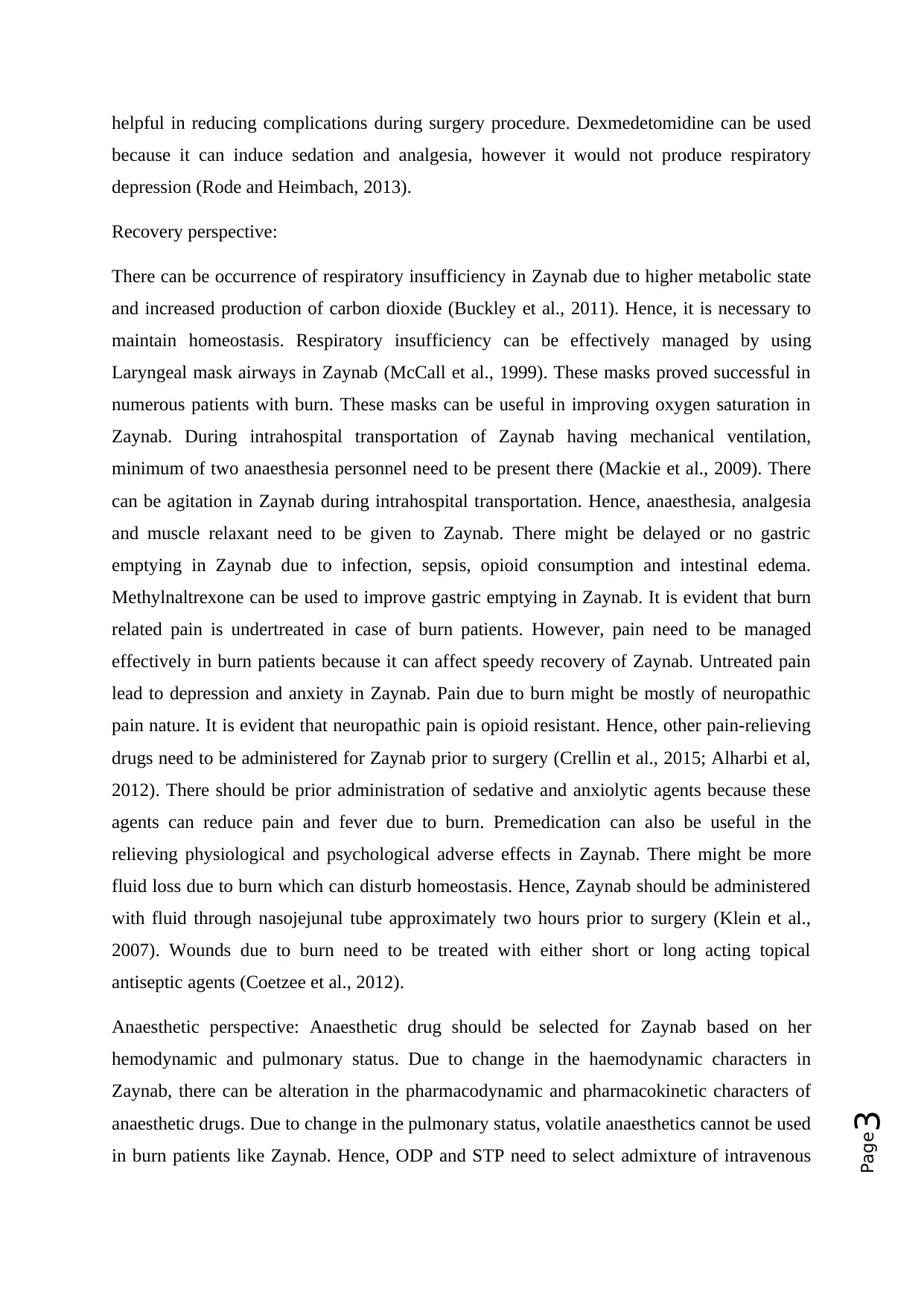
Page3
helpful in reducing complications during surgery procedure. Dexmedetomidine can be used
because it can induce sedation and analgesia, however it would not produce respiratory
depression (Rode and Heimbach, 2013).
Recovery perspective:
There can be occurrence of respiratory insufficiency in Zaynab due to higher metabolic state
and increased production of carbon dioxide (Buckley et al., 2011). Hence, it is necessary to
maintain homeostasis. Respiratory insufficiency can be effectively managed by using
Laryngeal mask airways in Zaynab (McCall et al., 1999). These masks proved successful in
numerous patients with burn. These masks can be useful in improving oxygen saturation in
Zaynab. During intrahospital transportation of Zaynab having mechanical ventilation,
minimum of two anaesthesia personnel need to be present there (Mackie et al., 2009). There
can be agitation in Zaynab during intrahospital transportation. Hence, anaesthesia, analgesia
and muscle relaxant need to be given to Zaynab. There might be delayed or no gastric
emptying in Zaynab due to infection, sepsis, opioid consumption and intestinal edema.
Methylnaltrexone can be used to improve gastric emptying in Zaynab. It is evident that burn
related pain is undertreated in case of burn patients. However, pain need to be managed
effectively in burn patients because it can affect speedy recovery of Zaynab. Untreated pain
lead to depression and anxiety in Zaynab. Pain due to burn might be mostly of neuropathic
pain nature. It is evident that neuropathic pain is opioid resistant. Hence, other pain-relieving
drugs need to be administered for Zaynab prior to surgery (Crellin et al., 2015; Alharbi et al,
2012). There should be prior administration of sedative and anxiolytic agents because these
agents can reduce pain and fever due to burn. Premedication can also be useful in the
relieving physiological and psychological adverse effects in Zaynab. There might be more
fluid loss due to burn which can disturb homeostasis. Hence, Zaynab should be administered
with fluid through nasojejunal tube approximately two hours prior to surgery (Klein et al.,
2007). Wounds due to burn need to be treated with either short or long acting topical
antiseptic agents (Coetzee et al., 2012).
Anaesthetic perspective: Anaesthetic drug should be selected for Zaynab based on her
hemodynamic and pulmonary status. Due to change in the haemodynamic characters in
Zaynab, there can be alteration in the pharmacodynamic and pharmacokinetic characters of
anaesthetic drugs. Due to change in the pulmonary status, volatile anaesthetics cannot be used
in burn patients like Zaynab. Hence, ODP and STP need to select admixture of intravenous
helpful in reducing complications during surgery procedure. Dexmedetomidine can be used
because it can induce sedation and analgesia, however it would not produce respiratory
depression (Rode and Heimbach, 2013).
Recovery perspective:
There can be occurrence of respiratory insufficiency in Zaynab due to higher metabolic state
and increased production of carbon dioxide (Buckley et al., 2011). Hence, it is necessary to
maintain homeostasis. Respiratory insufficiency can be effectively managed by using
Laryngeal mask airways in Zaynab (McCall et al., 1999). These masks proved successful in
numerous patients with burn. These masks can be useful in improving oxygen saturation in
Zaynab. During intrahospital transportation of Zaynab having mechanical ventilation,
minimum of two anaesthesia personnel need to be present there (Mackie et al., 2009). There
can be agitation in Zaynab during intrahospital transportation. Hence, anaesthesia, analgesia
and muscle relaxant need to be given to Zaynab. There might be delayed or no gastric
emptying in Zaynab due to infection, sepsis, opioid consumption and intestinal edema.
Methylnaltrexone can be used to improve gastric emptying in Zaynab. It is evident that burn
related pain is undertreated in case of burn patients. However, pain need to be managed
effectively in burn patients because it can affect speedy recovery of Zaynab. Untreated pain
lead to depression and anxiety in Zaynab. Pain due to burn might be mostly of neuropathic
pain nature. It is evident that neuropathic pain is opioid resistant. Hence, other pain-relieving
drugs need to be administered for Zaynab prior to surgery (Crellin et al., 2015; Alharbi et al,
2012). There should be prior administration of sedative and anxiolytic agents because these
agents can reduce pain and fever due to burn. Premedication can also be useful in the
relieving physiological and psychological adverse effects in Zaynab. There might be more
fluid loss due to burn which can disturb homeostasis. Hence, Zaynab should be administered
with fluid through nasojejunal tube approximately two hours prior to surgery (Klein et al.,
2007). Wounds due to burn need to be treated with either short or long acting topical
antiseptic agents (Coetzee et al., 2012).
Anaesthetic perspective: Anaesthetic drug should be selected for Zaynab based on her
hemodynamic and pulmonary status. Due to change in the haemodynamic characters in
Zaynab, there can be alteration in the pharmacodynamic and pharmacokinetic characters of
anaesthetic drugs. Due to change in the pulmonary status, volatile anaesthetics cannot be used
in burn patients like Zaynab. Hence, ODP and STP need to select admixture of intravenous
⊘ This is a preview!⊘
Do you want full access?
Subscribe today to unlock all pages.

Trusted by 1+ million students worldwide
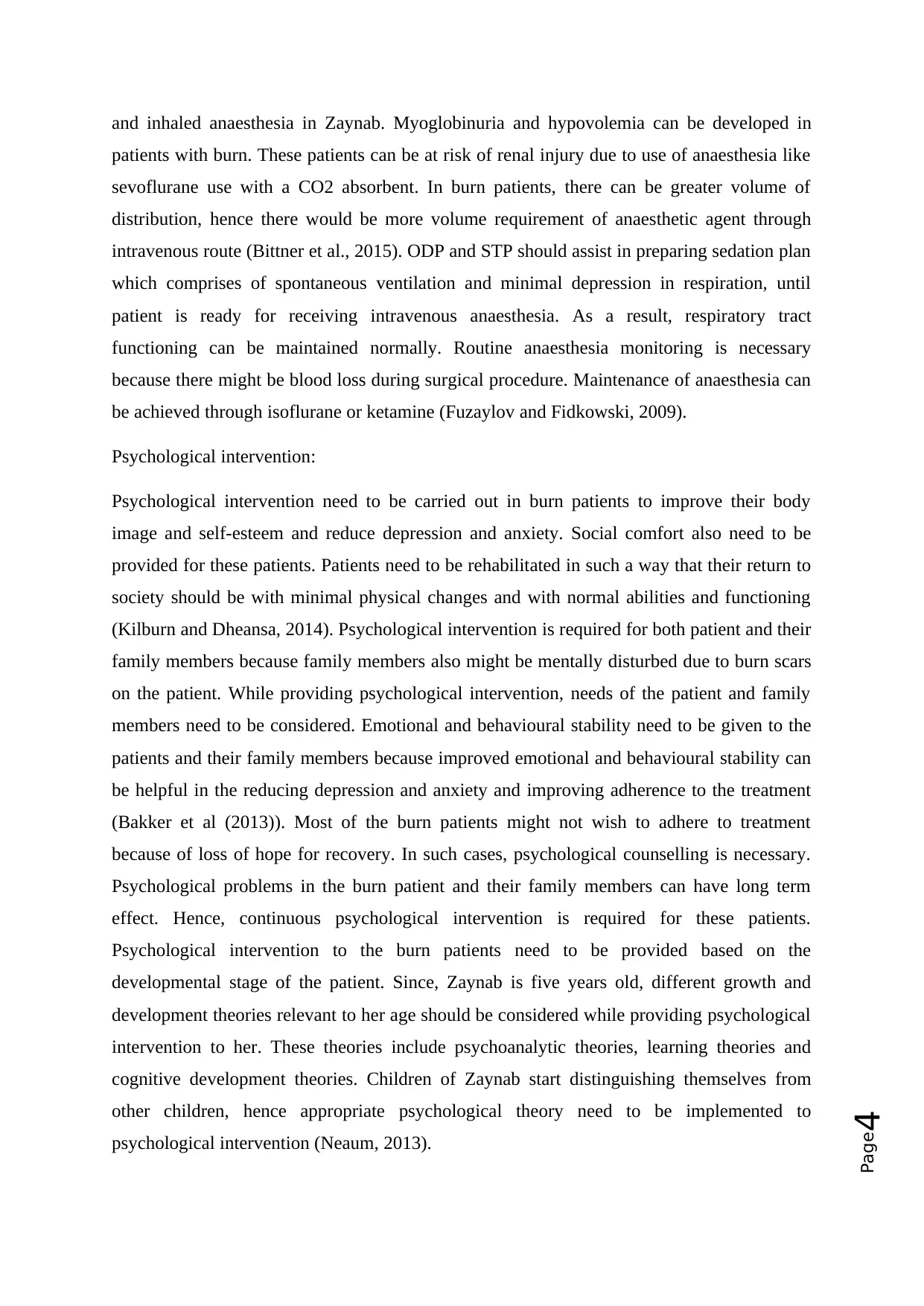
Page4
and inhaled anaesthesia in Zaynab. Myoglobinuria and hypovolemia can be developed in
patients with burn. These patients can be at risk of renal injury due to use of anaesthesia like
sevoflurane use with a CO2 absorbent. In burn patients, there can be greater volume of
distribution, hence there would be more volume requirement of anaesthetic agent through
intravenous route (Bittner et al., 2015). ODP and STP should assist in preparing sedation plan
which comprises of spontaneous ventilation and minimal depression in respiration, until
patient is ready for receiving intravenous anaesthesia. As a result, respiratory tract
functioning can be maintained normally. Routine anaesthesia monitoring is necessary
because there might be blood loss during surgical procedure. Maintenance of anaesthesia can
be achieved through isoflurane or ketamine (Fuzaylov and Fidkowski, 2009).
Psychological intervention:
Psychological intervention need to be carried out in burn patients to improve their body
image and self-esteem and reduce depression and anxiety. Social comfort also need to be
provided for these patients. Patients need to be rehabilitated in such a way that their return to
society should be with minimal physical changes and with normal abilities and functioning
(Kilburn and Dheansa, 2014). Psychological intervention is required for both patient and their
family members because family members also might be mentally disturbed due to burn scars
on the patient. While providing psychological intervention, needs of the patient and family
members need to be considered. Emotional and behavioural stability need to be given to the
patients and their family members because improved emotional and behavioural stability can
be helpful in the reducing depression and anxiety and improving adherence to the treatment
(Bakker et al (2013)). Most of the burn patients might not wish to adhere to treatment
because of loss of hope for recovery. In such cases, psychological counselling is necessary.
Psychological problems in the burn patient and their family members can have long term
effect. Hence, continuous psychological intervention is required for these patients.
Psychological intervention to the burn patients need to be provided based on the
developmental stage of the patient. Since, Zaynab is five years old, different growth and
development theories relevant to her age should be considered while providing psychological
intervention to her. These theories include psychoanalytic theories, learning theories and
cognitive development theories. Children of Zaynab start distinguishing themselves from
other children, hence appropriate psychological theory need to be implemented to
psychological intervention (Neaum, 2013).
and inhaled anaesthesia in Zaynab. Myoglobinuria and hypovolemia can be developed in
patients with burn. These patients can be at risk of renal injury due to use of anaesthesia like
sevoflurane use with a CO2 absorbent. In burn patients, there can be greater volume of
distribution, hence there would be more volume requirement of anaesthetic agent through
intravenous route (Bittner et al., 2015). ODP and STP should assist in preparing sedation plan
which comprises of spontaneous ventilation and minimal depression in respiration, until
patient is ready for receiving intravenous anaesthesia. As a result, respiratory tract
functioning can be maintained normally. Routine anaesthesia monitoring is necessary
because there might be blood loss during surgical procedure. Maintenance of anaesthesia can
be achieved through isoflurane or ketamine (Fuzaylov and Fidkowski, 2009).
Psychological intervention:
Psychological intervention need to be carried out in burn patients to improve their body
image and self-esteem and reduce depression and anxiety. Social comfort also need to be
provided for these patients. Patients need to be rehabilitated in such a way that their return to
society should be with minimal physical changes and with normal abilities and functioning
(Kilburn and Dheansa, 2014). Psychological intervention is required for both patient and their
family members because family members also might be mentally disturbed due to burn scars
on the patient. While providing psychological intervention, needs of the patient and family
members need to be considered. Emotional and behavioural stability need to be given to the
patients and their family members because improved emotional and behavioural stability can
be helpful in the reducing depression and anxiety and improving adherence to the treatment
(Bakker et al (2013)). Most of the burn patients might not wish to adhere to treatment
because of loss of hope for recovery. In such cases, psychological counselling is necessary.
Psychological problems in the burn patient and their family members can have long term
effect. Hence, continuous psychological intervention is required for these patients.
Psychological intervention to the burn patients need to be provided based on the
developmental stage of the patient. Since, Zaynab is five years old, different growth and
development theories relevant to her age should be considered while providing psychological
intervention to her. These theories include psychoanalytic theories, learning theories and
cognitive development theories. Children of Zaynab start distinguishing themselves from
other children, hence appropriate psychological theory need to be implemented to
psychological intervention (Neaum, 2013).
Paraphrase This Document
Need a fresh take? Get an instant paraphrase of this document with our AI Paraphraser
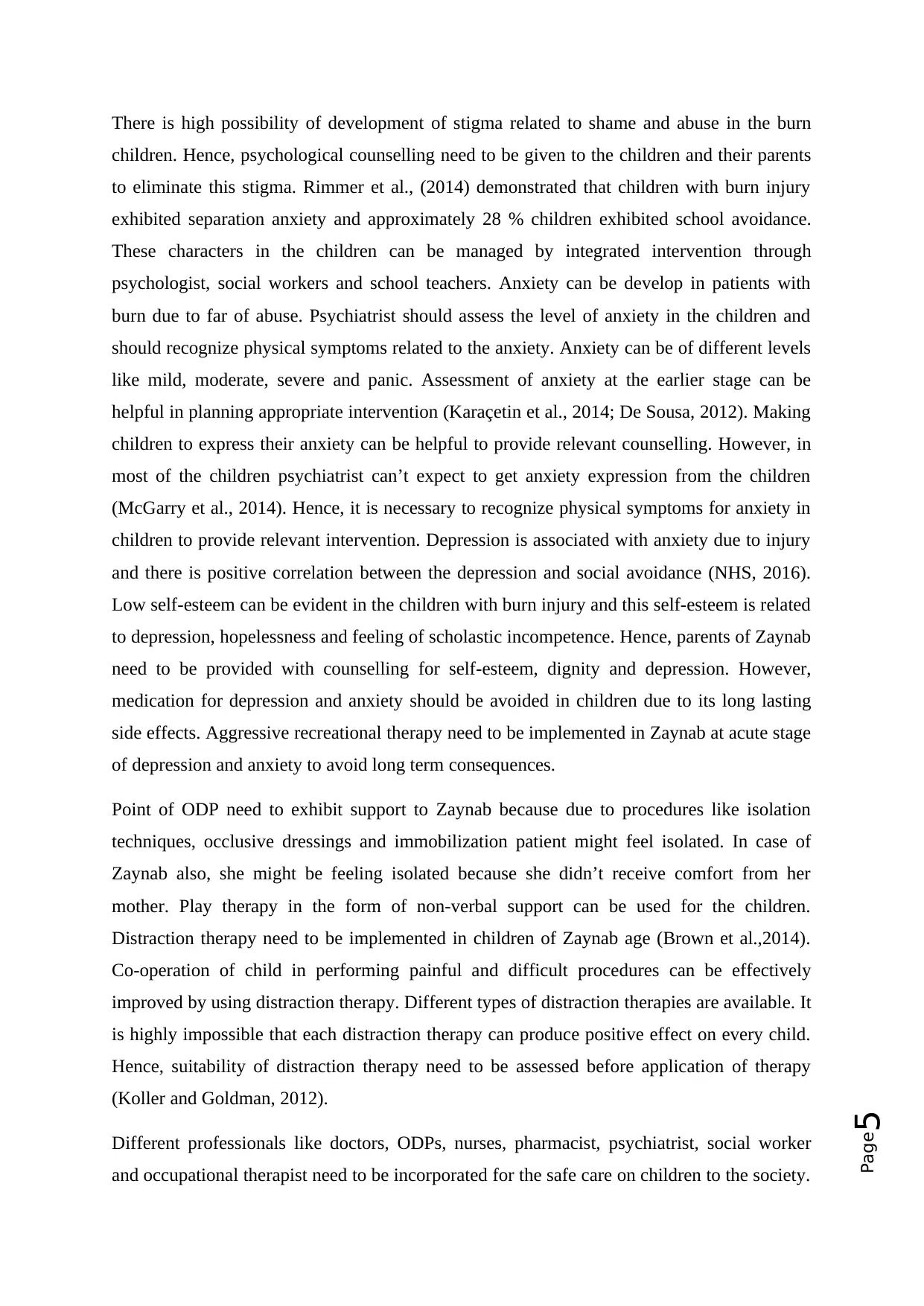
Page5
There is high possibility of development of stigma related to shame and abuse in the burn
children. Hence, psychological counselling need to be given to the children and their parents
to eliminate this stigma. Rimmer et al., (2014) demonstrated that children with burn injury
exhibited separation anxiety and approximately 28 % children exhibited school avoidance.
These characters in the children can be managed by integrated intervention through
psychologist, social workers and school teachers. Anxiety can be develop in patients with
burn due to far of abuse. Psychiatrist should assess the level of anxiety in the children and
should recognize physical symptoms related to the anxiety. Anxiety can be of different levels
like mild, moderate, severe and panic. Assessment of anxiety at the earlier stage can be
helpful in planning appropriate intervention (Karaçetin et al., 2014; De Sousa, 2012). Making
children to express their anxiety can be helpful to provide relevant counselling. However, in
most of the children psychiatrist can’t expect to get anxiety expression from the children
(McGarry et al., 2014). Hence, it is necessary to recognize physical symptoms for anxiety in
children to provide relevant intervention. Depression is associated with anxiety due to injury
and there is positive correlation between the depression and social avoidance (NHS, 2016).
Low self-esteem can be evident in the children with burn injury and this self-esteem is related
to depression, hopelessness and feeling of scholastic incompetence. Hence, parents of Zaynab
need to be provided with counselling for self-esteem, dignity and depression. However,
medication for depression and anxiety should be avoided in children due to its long lasting
side effects. Aggressive recreational therapy need to be implemented in Zaynab at acute stage
of depression and anxiety to avoid long term consequences.
Point of ODP need to exhibit support to Zaynab because due to procedures like isolation
techniques, occlusive dressings and immobilization patient might feel isolated. In case of
Zaynab also, she might be feeling isolated because she didn’t receive comfort from her
mother. Play therapy in the form of non-verbal support can be used for the children.
Distraction therapy need to be implemented in children of Zaynab age (Brown et al.,2014).
Co-operation of child in performing painful and difficult procedures can be effectively
improved by using distraction therapy. Different types of distraction therapies are available. It
is highly impossible that each distraction therapy can produce positive effect on every child.
Hence, suitability of distraction therapy need to be assessed before application of therapy
(Koller and Goldman, 2012).
Different professionals like doctors, ODPs, nurses, pharmacist, psychiatrist, social worker
and occupational therapist need to be incorporated for the safe care on children to the society.
There is high possibility of development of stigma related to shame and abuse in the burn
children. Hence, psychological counselling need to be given to the children and their parents
to eliminate this stigma. Rimmer et al., (2014) demonstrated that children with burn injury
exhibited separation anxiety and approximately 28 % children exhibited school avoidance.
These characters in the children can be managed by integrated intervention through
psychologist, social workers and school teachers. Anxiety can be develop in patients with
burn due to far of abuse. Psychiatrist should assess the level of anxiety in the children and
should recognize physical symptoms related to the anxiety. Anxiety can be of different levels
like mild, moderate, severe and panic. Assessment of anxiety at the earlier stage can be
helpful in planning appropriate intervention (Karaçetin et al., 2014; De Sousa, 2012). Making
children to express their anxiety can be helpful to provide relevant counselling. However, in
most of the children psychiatrist can’t expect to get anxiety expression from the children
(McGarry et al., 2014). Hence, it is necessary to recognize physical symptoms for anxiety in
children to provide relevant intervention. Depression is associated with anxiety due to injury
and there is positive correlation between the depression and social avoidance (NHS, 2016).
Low self-esteem can be evident in the children with burn injury and this self-esteem is related
to depression, hopelessness and feeling of scholastic incompetence. Hence, parents of Zaynab
need to be provided with counselling for self-esteem, dignity and depression. However,
medication for depression and anxiety should be avoided in children due to its long lasting
side effects. Aggressive recreational therapy need to be implemented in Zaynab at acute stage
of depression and anxiety to avoid long term consequences.
Point of ODP need to exhibit support to Zaynab because due to procedures like isolation
techniques, occlusive dressings and immobilization patient might feel isolated. In case of
Zaynab also, she might be feeling isolated because she didn’t receive comfort from her
mother. Play therapy in the form of non-verbal support can be used for the children.
Distraction therapy need to be implemented in children of Zaynab age (Brown et al.,2014).
Co-operation of child in performing painful and difficult procedures can be effectively
improved by using distraction therapy. Different types of distraction therapies are available. It
is highly impossible that each distraction therapy can produce positive effect on every child.
Hence, suitability of distraction therapy need to be assessed before application of therapy
(Koller and Goldman, 2012).
Different professionals like doctors, ODPs, nurses, pharmacist, psychiatrist, social worker
and occupational therapist need to be incorporated for the safe care on children to the society.
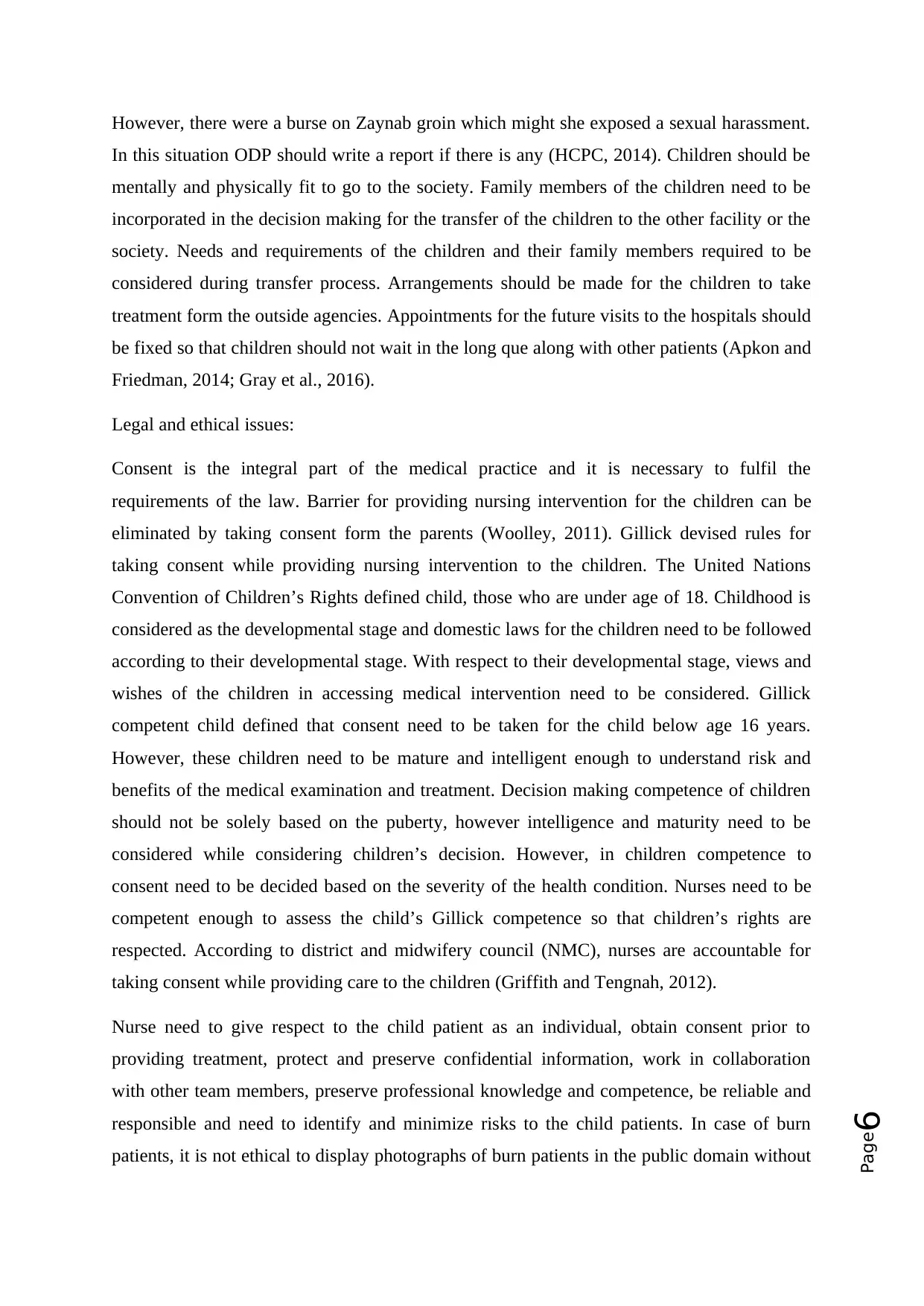
Page6
However, there were a burse on Zaynab groin which might she exposed a sexual harassment.
In this situation ODP should write a report if there is any (HCPC, 2014). Children should be
mentally and physically fit to go to the society. Family members of the children need to be
incorporated in the decision making for the transfer of the children to the other facility or the
society. Needs and requirements of the children and their family members required to be
considered during transfer process. Arrangements should be made for the children to take
treatment form the outside agencies. Appointments for the future visits to the hospitals should
be fixed so that children should not wait in the long que along with other patients (Apkon and
Friedman, 2014; Gray et al., 2016).
Legal and ethical issues:
Consent is the integral part of the medical practice and it is necessary to fulfil the
requirements of the law. Barrier for providing nursing intervention for the children can be
eliminated by taking consent form the parents (Woolley, 2011). Gillick devised rules for
taking consent while providing nursing intervention to the children. The United Nations
Convention of Children’s Rights defined child, those who are under age of 18. Childhood is
considered as the developmental stage and domestic laws for the children need to be followed
according to their developmental stage. With respect to their developmental stage, views and
wishes of the children in accessing medical intervention need to be considered. Gillick
competent child defined that consent need to be taken for the child below age 16 years.
However, these children need to be mature and intelligent enough to understand risk and
benefits of the medical examination and treatment. Decision making competence of children
should not be solely based on the puberty, however intelligence and maturity need to be
considered while considering children’s decision. However, in children competence to
consent need to be decided based on the severity of the health condition. Nurses need to be
competent enough to assess the child’s Gillick competence so that children’s rights are
respected. According to district and midwifery council (NMC), nurses are accountable for
taking consent while providing care to the children (Griffith and Tengnah, 2012).
Nurse need to give respect to the child patient as an individual, obtain consent prior to
providing treatment, protect and preserve confidential information, work in collaboration
with other team members, preserve professional knowledge and competence, be reliable and
responsible and need to identify and minimize risks to the child patients. In case of burn
patients, it is not ethical to display photographs of burn patients in the public domain without
However, there were a burse on Zaynab groin which might she exposed a sexual harassment.
In this situation ODP should write a report if there is any (HCPC, 2014). Children should be
mentally and physically fit to go to the society. Family members of the children need to be
incorporated in the decision making for the transfer of the children to the other facility or the
society. Needs and requirements of the children and their family members required to be
considered during transfer process. Arrangements should be made for the children to take
treatment form the outside agencies. Appointments for the future visits to the hospitals should
be fixed so that children should not wait in the long que along with other patients (Apkon and
Friedman, 2014; Gray et al., 2016).
Legal and ethical issues:
Consent is the integral part of the medical practice and it is necessary to fulfil the
requirements of the law. Barrier for providing nursing intervention for the children can be
eliminated by taking consent form the parents (Woolley, 2011). Gillick devised rules for
taking consent while providing nursing intervention to the children. The United Nations
Convention of Children’s Rights defined child, those who are under age of 18. Childhood is
considered as the developmental stage and domestic laws for the children need to be followed
according to their developmental stage. With respect to their developmental stage, views and
wishes of the children in accessing medical intervention need to be considered. Gillick
competent child defined that consent need to be taken for the child below age 16 years.
However, these children need to be mature and intelligent enough to understand risk and
benefits of the medical examination and treatment. Decision making competence of children
should not be solely based on the puberty, however intelligence and maturity need to be
considered while considering children’s decision. However, in children competence to
consent need to be decided based on the severity of the health condition. Nurses need to be
competent enough to assess the child’s Gillick competence so that children’s rights are
respected. According to district and midwifery council (NMC), nurses are accountable for
taking consent while providing care to the children (Griffith and Tengnah, 2012).
Nurse need to give respect to the child patient as an individual, obtain consent prior to
providing treatment, protect and preserve confidential information, work in collaboration
with other team members, preserve professional knowledge and competence, be reliable and
responsible and need to identify and minimize risks to the child patients. In case of burn
patients, it is not ethical to display photographs of burn patients in the public domain without
⊘ This is a preview!⊘
Do you want full access?
Subscribe today to unlock all pages.

Trusted by 1+ million students worldwide
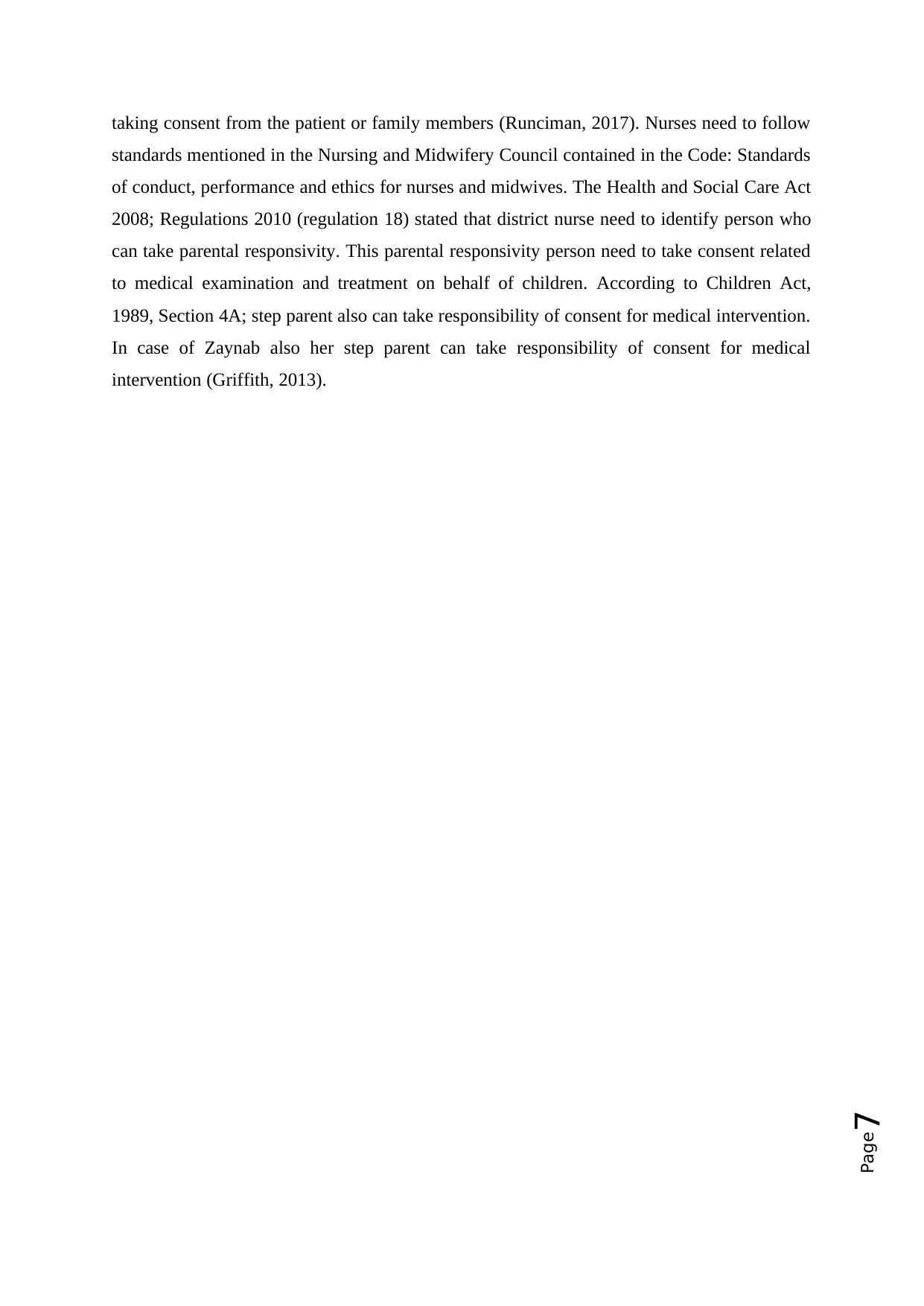
Page7
taking consent from the patient or family members (Runciman, 2017). Nurses need to follow
standards mentioned in the Nursing and Midwifery Council contained in the Code: Standards
of conduct, performance and ethics for nurses and midwives. The Health and Social Care Act
2008; Regulations 2010 (regulation 18) stated that district nurse need to identify person who
can take parental responsivity. This parental responsivity person need to take consent related
to medical examination and treatment on behalf of children. According to Children Act,
1989, Section 4A; step parent also can take responsibility of consent for medical intervention.
In case of Zaynab also her step parent can take responsibility of consent for medical
intervention (Griffith, 2013).
taking consent from the patient or family members (Runciman, 2017). Nurses need to follow
standards mentioned in the Nursing and Midwifery Council contained in the Code: Standards
of conduct, performance and ethics for nurses and midwives. The Health and Social Care Act
2008; Regulations 2010 (regulation 18) stated that district nurse need to identify person who
can take parental responsivity. This parental responsivity person need to take consent related
to medical examination and treatment on behalf of children. According to Children Act,
1989, Section 4A; step parent also can take responsibility of consent for medical intervention.
In case of Zaynab also her step parent can take responsibility of consent for medical
intervention (Griffith, 2013).
Paraphrase This Document
Need a fresh take? Get an instant paraphrase of this document with our AI Paraphraser
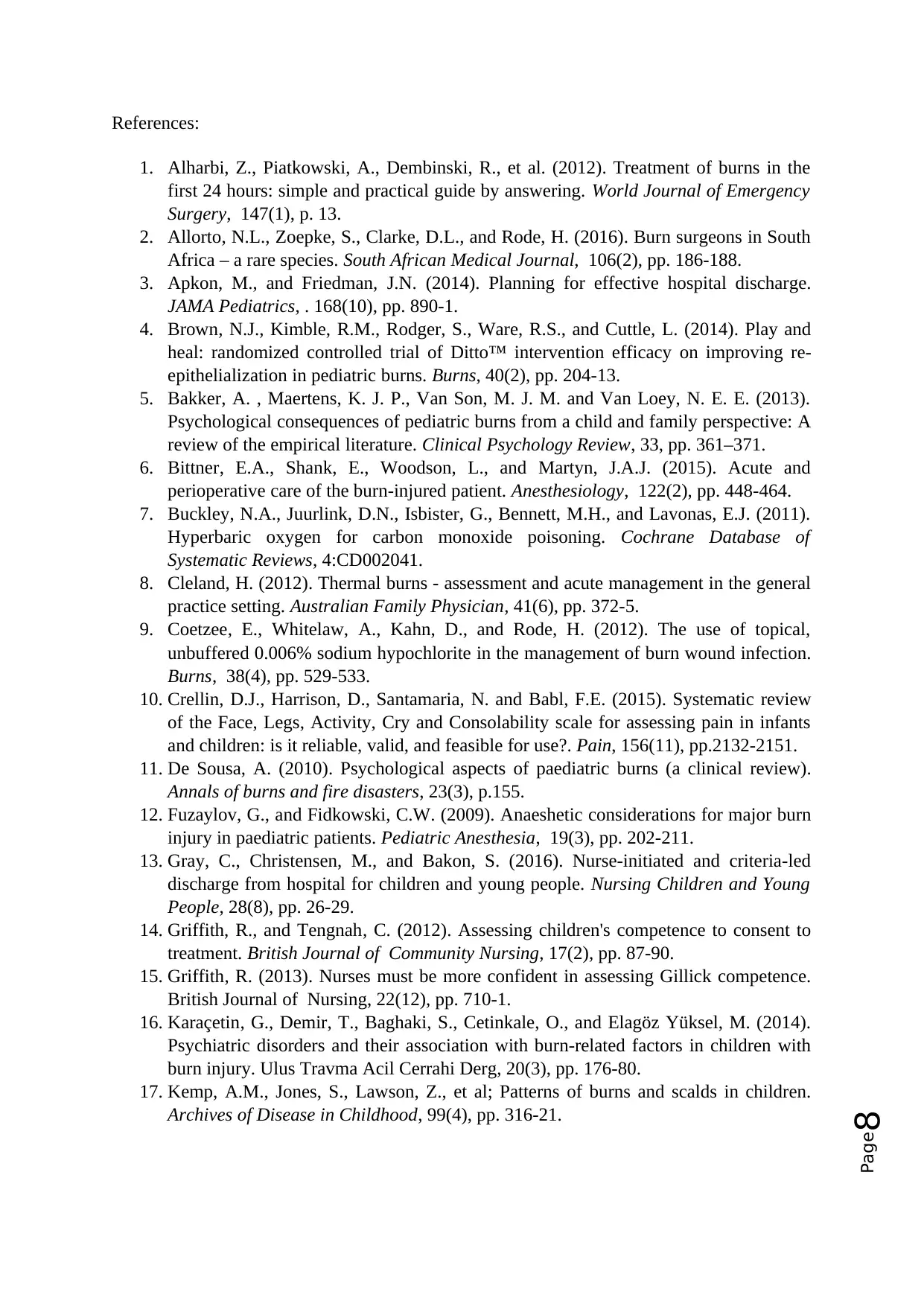
Page8
References:
1. Alharbi, Z., Piatkowski, A., Dembinski, R., et al. (2012). Treatment of burns in the
first 24 hours: simple and practical guide by answering. World Journal of Emergency
Surgery, 147(1), p. 13.
2. Allorto, N.L., Zoepke, S., Clarke, D.L., and Rode, H. (2016). Burn surgeons in South
Africa – a rare species. South African Medical Journal, 106(2), pp. 186-188.
3. Apkon, M., and Friedman, J.N. (2014). Planning for effective hospital discharge.
JAMA Pediatrics, . 168(10), pp. 890-1.
4. Brown, N.J., Kimble, R.M., Rodger, S., Ware, R.S., and Cuttle, L. (2014). Play and
heal: randomized controlled trial of Ditto™ intervention efficacy on improving re-
epithelialization in pediatric burns. Burns, 40(2), pp. 204-13.
5. Bakker, A. , Maertens, K. J. P., Van Son, M. J. M. and Van Loey, N. E. E. (2013).
Psychological consequences of pediatric burns from a child and family perspective: A
review of the empirical literature. Clinical Psychology Review, 33, pp. 361–371.
6. Bittner, E.A., Shank, E., Woodson, L., and Martyn, J.A.J. (2015). Acute and
perioperative care of the burn-injured patient. Anesthesiology, 122(2), pp. 448-464.
7. Buckley, N.A., Juurlink, D.N., Isbister, G., Bennett, M.H., and Lavonas, E.J. (2011).
Hyperbaric oxygen for carbon monoxide poisoning. Cochrane Database of
Systematic Reviews, 4:CD002041.
8. Cleland, H. (2012). Thermal burns - assessment and acute management in the general
practice setting. Australian Family Physician, 41(6), pp. 372-5.
9. Coetzee, E., Whitelaw, A., Kahn, D., and Rode, H. (2012). The use of topical,
unbuffered 0.006% sodium hypochlorite in the management of burn wound infection.
Burns, 38(4), pp. 529-533.
10. Crellin, D.J., Harrison, D., Santamaria, N. and Babl, F.E. (2015). Systematic review
of the Face, Legs, Activity, Cry and Consolability scale for assessing pain in infants
and children: is it reliable, valid, and feasible for use?. Pain, 156(11), pp.2132-2151.
11. De Sousa, A. (2010). Psychological aspects of paediatric burns (a clinical review).
Annals of burns and fire disasters, 23(3), p.155.
12. Fuzaylov, G., and Fidkowski, C.W. (2009). Anaeshetic considerations for major burn
injury in paediatric patients. Pediatric Anesthesia, 19(3), pp. 202-211.
13. Gray, C., Christensen, M., and Bakon, S. (2016). Nurse-initiated and criteria-led
discharge from hospital for children and young people. Nursing Children and Young
People, 28(8), pp. 26-29.
14. Griffith, R., and Tengnah, C. (2012). Assessing children's competence to consent to
treatment. British Journal of Community Nursing, 17(2), pp. 87-90.
15. Griffith, R. (2013). Nurses must be more confident in assessing Gillick competence.
British Journal of Nursing, 22(12), pp. 710-1.
16. Karaçetin, G., Demir, T., Baghaki, S., Cetinkale, O., and Elagöz Yüksel, M. (2014).
Psychiatric disorders and their association with burn-related factors in children with
burn injury. Ulus Travma Acil Cerrahi Derg, 20(3), pp. 176-80.
17. Kemp, A.M., Jones, S., Lawson, Z., et al; Patterns of burns and scalds in children.
Archives of Disease in Childhood, 99(4), pp. 316-21.
References:
1. Alharbi, Z., Piatkowski, A., Dembinski, R., et al. (2012). Treatment of burns in the
first 24 hours: simple and practical guide by answering. World Journal of Emergency
Surgery, 147(1), p. 13.
2. Allorto, N.L., Zoepke, S., Clarke, D.L., and Rode, H. (2016). Burn surgeons in South
Africa – a rare species. South African Medical Journal, 106(2), pp. 186-188.
3. Apkon, M., and Friedman, J.N. (2014). Planning for effective hospital discharge.
JAMA Pediatrics, . 168(10), pp. 890-1.
4. Brown, N.J., Kimble, R.M., Rodger, S., Ware, R.S., and Cuttle, L. (2014). Play and
heal: randomized controlled trial of Ditto™ intervention efficacy on improving re-
epithelialization in pediatric burns. Burns, 40(2), pp. 204-13.
5. Bakker, A. , Maertens, K. J. P., Van Son, M. J. M. and Van Loey, N. E. E. (2013).
Psychological consequences of pediatric burns from a child and family perspective: A
review of the empirical literature. Clinical Psychology Review, 33, pp. 361–371.
6. Bittner, E.A., Shank, E., Woodson, L., and Martyn, J.A.J. (2015). Acute and
perioperative care of the burn-injured patient. Anesthesiology, 122(2), pp. 448-464.
7. Buckley, N.A., Juurlink, D.N., Isbister, G., Bennett, M.H., and Lavonas, E.J. (2011).
Hyperbaric oxygen for carbon monoxide poisoning. Cochrane Database of
Systematic Reviews, 4:CD002041.
8. Cleland, H. (2012). Thermal burns - assessment and acute management in the general
practice setting. Australian Family Physician, 41(6), pp. 372-5.
9. Coetzee, E., Whitelaw, A., Kahn, D., and Rode, H. (2012). The use of topical,
unbuffered 0.006% sodium hypochlorite in the management of burn wound infection.
Burns, 38(4), pp. 529-533.
10. Crellin, D.J., Harrison, D., Santamaria, N. and Babl, F.E. (2015). Systematic review
of the Face, Legs, Activity, Cry and Consolability scale for assessing pain in infants
and children: is it reliable, valid, and feasible for use?. Pain, 156(11), pp.2132-2151.
11. De Sousa, A. (2010). Psychological aspects of paediatric burns (a clinical review).
Annals of burns and fire disasters, 23(3), p.155.
12. Fuzaylov, G., and Fidkowski, C.W. (2009). Anaeshetic considerations for major burn
injury in paediatric patients. Pediatric Anesthesia, 19(3), pp. 202-211.
13. Gray, C., Christensen, M., and Bakon, S. (2016). Nurse-initiated and criteria-led
discharge from hospital for children and young people. Nursing Children and Young
People, 28(8), pp. 26-29.
14. Griffith, R., and Tengnah, C. (2012). Assessing children's competence to consent to
treatment. British Journal of Community Nursing, 17(2), pp. 87-90.
15. Griffith, R. (2013). Nurses must be more confident in assessing Gillick competence.
British Journal of Nursing, 22(12), pp. 710-1.
16. Karaçetin, G., Demir, T., Baghaki, S., Cetinkale, O., and Elagöz Yüksel, M. (2014).
Psychiatric disorders and their association with burn-related factors in children with
burn injury. Ulus Travma Acil Cerrahi Derg, 20(3), pp. 176-80.
17. Kemp, A.M., Jones, S., Lawson, Z., et al; Patterns of burns and scalds in children.
Archives of Disease in Childhood, 99(4), pp. 316-21.
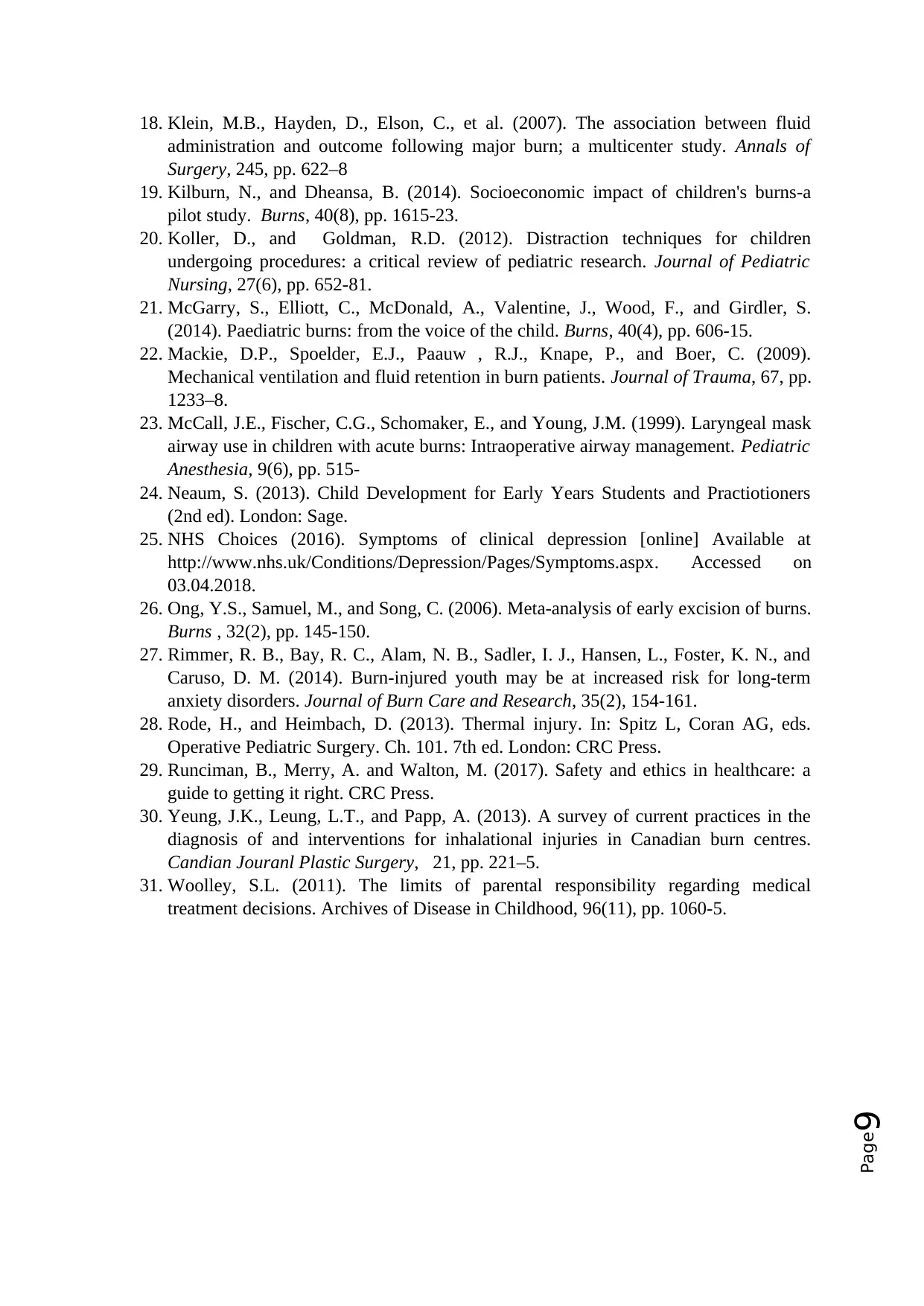
Page9
18. Klein, M.B., Hayden, D., Elson, C., et al. (2007). The association between fluid
administration and outcome following major burn; a multicenter study. Annals of
Surgery, 245, pp. 622–8
19. Kilburn, N., and Dheansa, B. (2014). Socioeconomic impact of children's burns-a
pilot study. Burns, 40(8), pp. 1615-23.
20. Koller, D., and Goldman, R.D. (2012). Distraction techniques for children
undergoing procedures: a critical review of pediatric research. Journal of Pediatric
Nursing, 27(6), pp. 652-81.
21. McGarry, S., Elliott, C., McDonald, A., Valentine, J., Wood, F., and Girdler, S.
(2014). Paediatric burns: from the voice of the child. Burns, 40(4), pp. 606-15.
22. Mackie, D.P., Spoelder, E.J., Paauw , R.J., Knape, P., and Boer, C. (2009).
Mechanical ventilation and fluid retention in burn patients. Journal of Trauma, 67, pp.
1233–8.
23. McCall, J.E., Fischer, C.G., Schomaker, E., and Young, J.M. (1999). Laryngeal mask
airway use in children with acute burns: Intraoperative airway management. Pediatric
Anesthesia, 9(6), pp. 515-
24. Neaum, S. (2013). Child Development for Early Years Students and Practiotioners
(2nd ed). London: Sage.
25. NHS Choices (2016). Symptoms of clinical depression [online] Available at
http://www.nhs.uk/Conditions/Depression/Pages/Symptoms.aspx. Accessed on
03.04.2018.
26. Ong, Y.S., Samuel, M., and Song, C. (2006). Meta-analysis of early excision of burns.
Burns , 32(2), pp. 145-150.
27. Rimmer, R. B., Bay, R. C., Alam, N. B., Sadler, I. J., Hansen, L., Foster, K. N., and
Caruso, D. M. (2014). Burn-injured youth may be at increased risk for long-term
anxiety disorders. Journal of Burn Care and Research, 35(2), 154-161.
28. Rode, H., and Heimbach, D. (2013). Thermal injury. In: Spitz L, Coran AG, eds.
Operative Pediatric Surgery. Ch. 101. 7th ed. London: CRC Press.
29. Runciman, B., Merry, A. and Walton, M. (2017). Safety and ethics in healthcare: a
guide to getting it right. CRC Press.
30. Yeung, J.K., Leung, L.T., and Papp, A. (2013). A survey of current practices in the
diagnosis of and interventions for inhalational injuries in Canadian burn centres.
Candian Jouranl Plastic Surgery, 21, pp. 221–5.
31. Woolley, S.L. (2011). The limits of parental responsibility regarding medical
treatment decisions. Archives of Disease in Childhood, 96(11), pp. 1060-5.
18. Klein, M.B., Hayden, D., Elson, C., et al. (2007). The association between fluid
administration and outcome following major burn; a multicenter study. Annals of
Surgery, 245, pp. 622–8
19. Kilburn, N., and Dheansa, B. (2014). Socioeconomic impact of children's burns-a
pilot study. Burns, 40(8), pp. 1615-23.
20. Koller, D., and Goldman, R.D. (2012). Distraction techniques for children
undergoing procedures: a critical review of pediatric research. Journal of Pediatric
Nursing, 27(6), pp. 652-81.
21. McGarry, S., Elliott, C., McDonald, A., Valentine, J., Wood, F., and Girdler, S.
(2014). Paediatric burns: from the voice of the child. Burns, 40(4), pp. 606-15.
22. Mackie, D.P., Spoelder, E.J., Paauw , R.J., Knape, P., and Boer, C. (2009).
Mechanical ventilation and fluid retention in burn patients. Journal of Trauma, 67, pp.
1233–8.
23. McCall, J.E., Fischer, C.G., Schomaker, E., and Young, J.M. (1999). Laryngeal mask
airway use in children with acute burns: Intraoperative airway management. Pediatric
Anesthesia, 9(6), pp. 515-
24. Neaum, S. (2013). Child Development for Early Years Students and Practiotioners
(2nd ed). London: Sage.
25. NHS Choices (2016). Symptoms of clinical depression [online] Available at
http://www.nhs.uk/Conditions/Depression/Pages/Symptoms.aspx. Accessed on
03.04.2018.
26. Ong, Y.S., Samuel, M., and Song, C. (2006). Meta-analysis of early excision of burns.
Burns , 32(2), pp. 145-150.
27. Rimmer, R. B., Bay, R. C., Alam, N. B., Sadler, I. J., Hansen, L., Foster, K. N., and
Caruso, D. M. (2014). Burn-injured youth may be at increased risk for long-term
anxiety disorders. Journal of Burn Care and Research, 35(2), 154-161.
28. Rode, H., and Heimbach, D. (2013). Thermal injury. In: Spitz L, Coran AG, eds.
Operative Pediatric Surgery. Ch. 101. 7th ed. London: CRC Press.
29. Runciman, B., Merry, A. and Walton, M. (2017). Safety and ethics in healthcare: a
guide to getting it right. CRC Press.
30. Yeung, J.K., Leung, L.T., and Papp, A. (2013). A survey of current practices in the
diagnosis of and interventions for inhalational injuries in Canadian burn centres.
Candian Jouranl Plastic Surgery, 21, pp. 221–5.
31. Woolley, S.L. (2011). The limits of parental responsibility regarding medical
treatment decisions. Archives of Disease in Childhood, 96(11), pp. 1060-5.
⊘ This is a preview!⊘
Do you want full access?
Subscribe today to unlock all pages.

Trusted by 1+ million students worldwide
1 out of 9
Your All-in-One AI-Powered Toolkit for Academic Success.
+13062052269
info@desklib.com
Available 24*7 on WhatsApp / Email
![[object Object]](/_next/static/media/star-bottom.7253800d.svg)
Unlock your academic potential
Copyright © 2020–2025 A2Z Services. All Rights Reserved. Developed and managed by ZUCOL.
